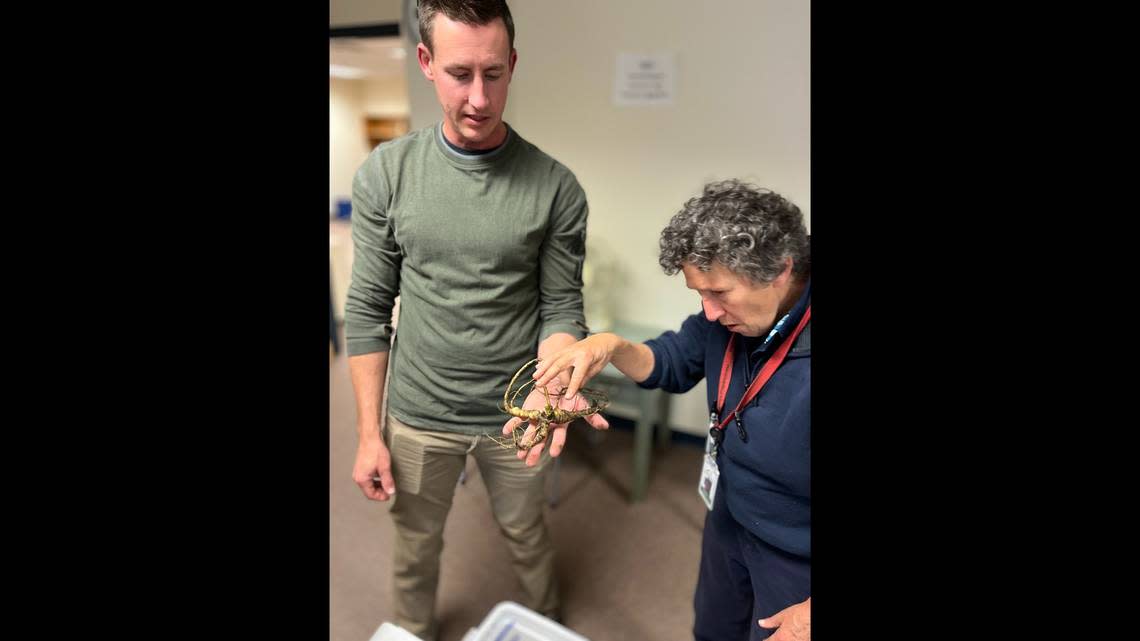93-year-old ginseng root could be sold for thousands. Here’s why it’s so valuable
A 93-year-old ginseng root found in the wild could be sold for hundreds — or even thousands — of dollars at an auction, agriculture officials in Vermont say.
The age of the tan-colored, twisted herb is important and was confirmed by the Vermont Agency of Agriculture after it was harvested in the state, where American ginseng is known to grow, according to an Oct. 14 Facebook post shared by the agency.
Now the ginseng root will be auctioned off in Chinatown in New York City, officials say.
The 93-year-old root was found in western Vermont on private property sometime between September or early October, Emilie Inoue, who supervises agency’s Plant Health department, told McClatchy News in a statement on Oct. 18. Inoue said the agency can only provide broad information about where wild roots are discovered, as there’s state laws in place regarding rules for harvesting.
“It’s not often that we see a root that old or that beautifully formed,” Inoue added.
But why are people willing to pay a high price for the herb?
Why Ginseng root is so valuable
Ginseng root has medicinal properties and has commonly been used in Chinese medicine for thousands of years, according to the U.S. Department of Agriculture. Historically, American Indians have also used American ginseng.
If American ginseng is harvested in the wild, it is worth much more than when the roots are grown and produced, the agency says.
“Ginseng has become one of the most popular herbs of the 1990’s as Americans and Europeans seek alternatives to prescription drugs,” the USDA Forest Service said in 1999. “Unfortunately many of the ginseng products available in local stores do not contain any American ginseng.”
From 2000 through 2007, ginseng root harvesters made about $22 million to up to $43 million each year on average from selling ginseng root found in the wild, according to the Agriculture Department.
One root on its own could be worth $17,000, Business Insider reports.
Ginseng is has earned the nickname “man-root” due to its person-like shape, and its potential health benefits are wide-ranging, according to the University of Rochester Medical Center in New York.
While more research on ginseng root’s benefit in people is needed, it has been said to provide an immune system boost, help with memory and mental performance, as well as physical performance, the university reports online. So far, animal studies involving ginseng have demonstrated the herb helps with stamina.
A few studies involving people suggested that American ginseng could benefit those with type 2 diabetes, as it lowered blood sugar, according to the Mount Sinai Health System in New York.
What’s more is that American Indians would use the root for headaches, fevers, indigestion and infertility, Mount Sinai reports online. Additionally, they would take it as a stimulant.
Inoue told McClatchy News that wild ginseng has been particularly important to the indigenous people of Vermont — the Abenaki tribe — for thousands of years due to its medicinal uses.
“They only collect what they can use because of their deeply held philosophy that medicine shouldn’t be used for profit,” Inoue said. “Instead, the root has historically and continues to be used by the Abenaki to heal ailments experienced within their communities.”
“There is deep concern within the Abenaki community for the ginseng population’s health because of overharvesting for economic gain,” Inoue added.
The age of a ginseng root is revealed from its “stem scars” or leaves, according to the Vermont Agency of Agriculture.
Inoue said while a ginseng root’s age often contributes to its monetary value, that’s not always the case. The form and size of each root can also contribute to its price.
The 93-year-old root recently harvested in Vermont was “beautifully formed and of significant size,” she said.

“Each root is so unique, it’s impossible to make generalizations, but a root that old indicates that it’s been alive a lot longer than most of the US population—the ‘grit’ demonstrated by the plant to persist through so many long winters in the harsh Vermont climate is also special,” Inoue added.
Not everyone can harvest ginseng root in Vermont
To harvest wild ginseng root in Vermont, there are rules and a collector’s permit is needed, the Vermont Agency of Agriculture says. Harvesting the herb is allowed from Sept. 1 through Oct. 31.
So before anyone thinks “we’re going to be rich...all we have to do is find some really old ginseng root,” Inoue said “people should familiarize themselves with the law regarding ginseng collecting.”
Four things people should know about wild ginseng, according to Inoue, is that:
“Collecting roots is not as easy as one might think.”
“Harvesting can only happen on private property (with permission).“
“There are required minimum age stipulations for harvesting of ginseng.”
“The impact of illegal and uninformed collectors is detrimental environmentally and culturally.”
It is legal in the state for people to cultivate ginseng, but it will likely not be worth as much as wild ginseng, according to Inoue.
American ginseng has been harvested in the U.S. since the late 1800s, according to the USDA Forest Service. It can be found in the northeast, southeast and midwest.
Wild horses can prevent out-of-control wildfires out west, researcher says. Here’s how
Invasive wasp from Asia found in North Carolina for the first time, state reports
Traveler’s baggage hid ‘biological materials’ that had to be incinerated, officials say
Birds dying in glue traps meant to kill invasive spotted lanternflies in NJ, group says
